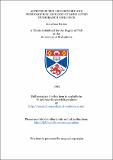Aspects of the life history and physiological ecology of long-lived nudibranch molluscs
Abstract
Nudibranchia is the major Order of the gastropod Sub-class Opisthobranchia. Nudibranchs demonstrate a considerable evolutionary departure from the typical shelled gastropod and have achieved wide morphological and ecological diversity. Most species are recorded from nearshore rocky habitats where they are primary macrobenthic predators; most species are stenophagous limited to a single, or a few, prey species. Previous investigations had shown that most nudibranch species have evolved to an annual semelparous life history strategy and adopt a planktotrophic larval development strategy which would appear to be the ancestral conditions. Reviews of published data had drawn attention to some species which demonstrated an evolutionary departure from these ancestral modes and had evolved extended life history strategies combined with more advanced larval development strategies. Archidoris pseudoargus and Cadlina laevis are sponge-grazing dorid nudibranchs, and Tritonia hombergi, which feeds on an alyconarean soft coral, appeared to have extended life cycles. The aim of the present study was to investigate the life history and larval development strategies of these species and, via a study their physiological ecology, attempt to determine the selective forces which may have driven any evolutionary departure away from the ancestral condition. Archidoris pseudoargus was found to have a biennial semelparous life history strategy and a planktotrophic larval development strategy; the planktotrophic lai'vae were found to have some characteristics of the more advanced lecithotrophic laeval form. Cadlina laevis was found to have a perennial iteropalous life history strategy and a direct mode of larval development; this was the first observation of perennial iteroparity in the Order Nudibranchia. Archidoris pseudoargus and Cadlina laevis had markedly seasonal growth patterns with a high growth rate in spring and early summer, followed by a period of reduced growth, or even degrowth in late summer and over the winter. An allometric relationship was determined between body size and feeding rate for A. pseudoargus; the exponent was less than unity. For both species, a significant allometric relationship was determined between body size and respiration rate with an exponent less than unity indicating an increase in metabolic efficiency with body size. Both species displayed an acclimatization of respiration rate with increasing temperature; the acclimatization was more pronounced in C. laevis. Fecundity of both species was shown to have a significant allometric relationship body size with an exponent less than unity. Insufficient numbers of T. hombergi were collected and kept alive in the laboratory to undertake any experiments to generate meaningful data to answer these principal questions for this species. Results of the present study together with data published from previous investigations have been interpreted to suggest that the extension of the life cycle is a consequence of seasonal variations in prey quality and quantity. Rather than being an exception to the rule, it is suggested that extended life cycles could be the ancestral condition and the more common annual/sub annual life cycles would be a more adapted condition. These conclusions are based on the results obtained from laboratory investigations which are discussed in their application to the field situation.
Type
Thesis, PhD Doctor of Philosophy
Collections
Items in the St Andrews Research Repository are protected by copyright, with all rights reserved, unless otherwise indicated.

